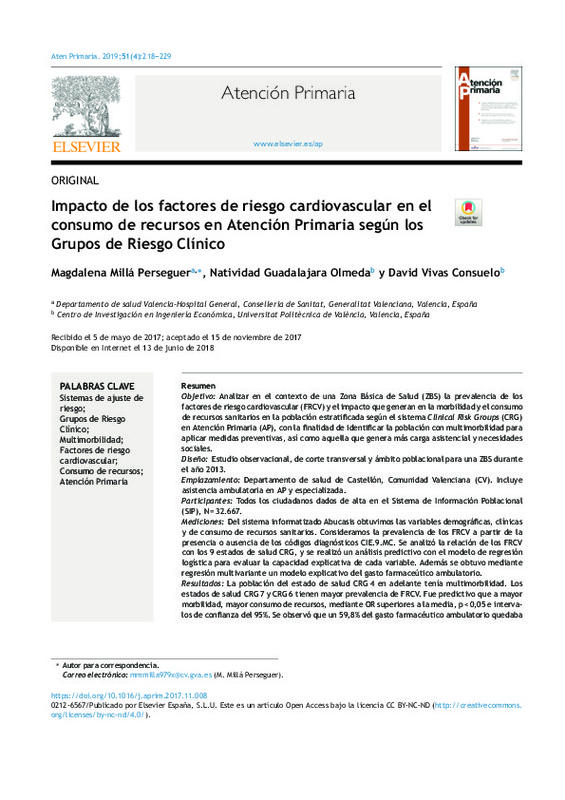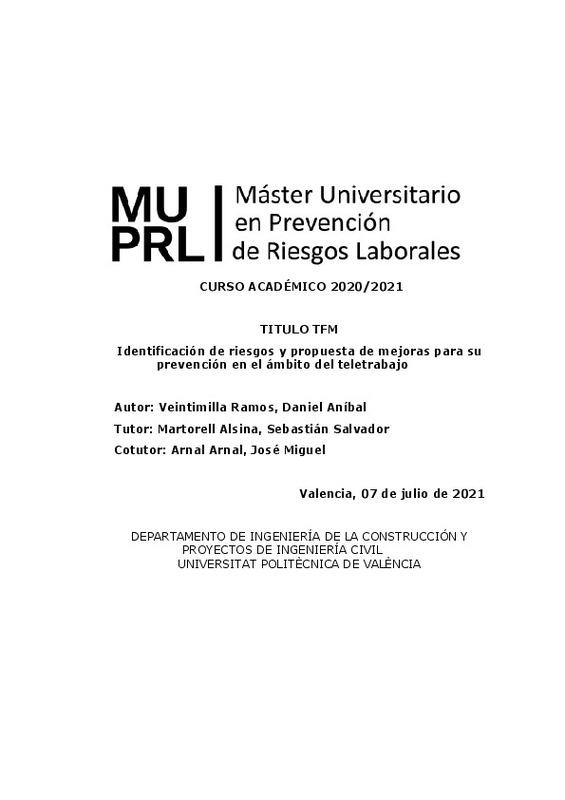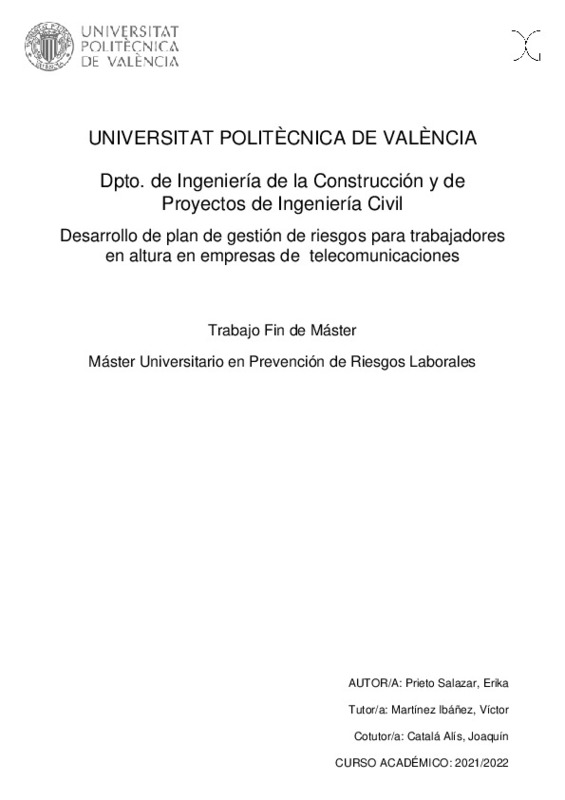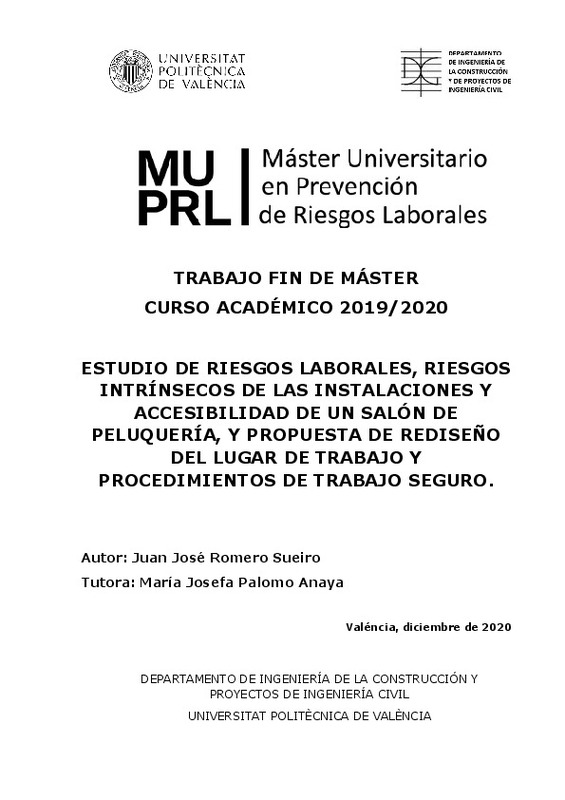JavaScript is disabled for your browser. Some features of this site may not work without it.
Buscar en RiuNet
Listar
Mi cuenta
Estadísticas
Ayuda RiuNet
Admin. UPV
Impacto de los factores de riesgo cardiovascular en el consumo de recursos en Atención Primaria según los Grupos de Riesgo Clínico
Mostrar el registro sencillo del ítem
Ficheros en el ítem
| dc.contributor.author | Millá-Perseguer, M.
|
es_ES |
| dc.contributor.author | Guadalajara Olmeda, María Natividad
|
es_ES |
| dc.contributor.author | Vivas-Consuelo, David
|
es_ES |
| dc.date.accessioned | 2020-11-05T04:33:42Z | |
| dc.date.available | 2020-11-05T04:33:42Z | |
| dc.date.issued | 2019-04 | es_ES |
| dc.identifier.issn | 0212-6567 | es_ES |
| dc.identifier.uri | http://hdl.handle.net/10251/154113 | |
| dc.description.abstract | [ES] Objetivo Analizar en el contexto de una Zona Básica de Salud (ZBS) la prevalencia de los factores de riesgo cardiovascular (FRCV) y el impacto que generan en la morbilidad y el consumo de recursos sanitarios en la población estratificada según el sistema Clinical Risk Groups (CRG) en Atención Primaria (AP), con la finalidad de identificar la población con multimorbilidad para aplicar medidas preventivas, así como aquella que genera más carga asistencial y necesidades sociales. Diseño Estudio observacional, de corte transversal y ámbito poblacional para una ZBS durante el año 2013. Emplazamiento Departamento de salud de Castellón, Comunidad Valenciana (CV). Incluye asistencia ambulatoria en AP y especializada. Participantes Todos los ciudadanos dados de alta en el Sistema de Información Poblacional (SIP), N = 32.667. Mediciones Del sistema informatizado Abucasis obtuvimos las variables demográficas, clínicas y de consumo de recursos sanitarios. Consideramos la prevalencia de los FRCV a partir de la presencia o ausencia de los códigos diagnósticos CIE.9.MC. Se analizó la relación de los FRCV con los 9 estados de salud CRG, y se realizó un análisis predictivo con el modelo de regresión logística para evaluar la capacidad explicativa de cada variable. Además se obtuvo mediante regresión multivariante un modelo explicativo del gasto farmaceútico ambulatorio. Resultados La población del estado de salud CRG 4 en adelante tenía multimorbilidad. Los estados de salud CRG 7 y CRG 6 tienen mayor prevalencia de FRCV. Fue predictivo que a mayor morbilidad, mayor consumo de recursos, mediante OR superiores a la media, p < 0,05 e intervalos de confianza del 95%. Se observó que un 59,8% del gasto farmacéutico ambulatorio quedaba explicado por el sistema CRG y todos los FRCV (p < 0,05 y R2 corregido = 0,598). En cuanto al efecto de los FRCV sobre los estados de salud CRG, hubo asociación significativa (p < 0,05) para la alteración de la glucemia, dislipidemia e HTA en todos los estados CRG. Conclusiones El estudio de los FRCV en una población estratificada mediante el sistema CRG identifica y predice dónde se genera mayor impacto en la morbilidad y consumo de recursos sanitarios. Nos permite conocer los grupos de pacientes en quienes desarrollar estrategias de prevención y cronicidad. A nivel de la práctica clínica se aporta un nuevo concepto de multimorbilidad, definido a partir del estado de salud CRG 4 en adelante. | es_ES |
| dc.description.abstract | [EN] Objective To analyze the prevalence of Cardiovascular Risk Factors (CVRF) in the context of a Basic Health Area and the impact they generate on morbidity and consumption of healthcare resources in the stratified population according to the Clinical System Risk Groups (CRG) in Primary Care, with the purpose of identifying the population with multimorbidity to apply preventive measures, as well as the one that generates the highest care burden and social needs. Design Observational, cross-sectional and population-based study for a basic health area during 2013. Location Department of Health 2 (Castellón), Comunidad Valenciana (CV). Includes outpatient care in Primary Care and specialized. Participants All citizens registered in the Population Information System, N = 32,667. Measurements From the computerized system Abucasis we obtained the demographic, clinical and consumption variables of health resources. We consider the prevalence of CVRF based on the presence or absence of the ICD.9.MC diagnostic codes. The relationship of the CVRF with the 9 CRG health states was analyzed and a predictive analysis was performed with the logistic regression model to evaluate the explanatory capacity of each variable. In addition, an explanatory model of ambulatory pharmaceutical expenditure was obtained through multivariate regression. Results The population of health status CRG 4 and above had multimorbidity. The CRG 7 and 6 health states have a higher prevalence of CVRF; it was predictive that the higher the morbidity, the greater the consumption of resources through OR above the mean, p < 0.05 and the 95% confidence intervals. It was observed that 59.8% of ambulatory pharmaceutical expenditure was explained by the CRG system and all the CVRF (p < 0.05 and R2 corrected = 0.598). Regarding the effect of the CVRF on the CRG health states, there was a significant association (p < 0.05) for the alteration of blood glucose, dyslipidemia and HBP in all the CRG states. Conclusions The study of CVRF in a stratified population using the CRG system identifies and predicts where the greatest impact on morbidity and consumption of healthcare resources is generated. It allows us to know the groups of patients where to develop prevention and chronicity strategies. At the level of clinical practice, a new concept of multimorbidity is provided, defined from the state of health CRG 4 and above. | es_ES |
| dc.language | Español | es_ES |
| dc.publisher | Elsevier | es_ES |
| dc.relation.ispartof | Atención Primaria | es_ES |
| dc.rights | Reconocimiento - No comercial - Sin obra derivada (by-nc-nd) | es_ES |
| dc.subject | Sistemas de ajuste de riesgo | es_ES |
| dc.subject | Grupos de Riesgo Clínico | es_ES |
| dc.subject | Multimorbilidad | es_ES |
| dc.subject | Factores de riesgo cardiovascular | es_ES |
| dc.subject | Consumo de recursos | es_ES |
| dc.subject | Atención Primaria | es_ES |
| dc.subject | Risk adjustment systems | es_ES |
| dc.subject | Clinical Risk Groups | es_ES |
| dc.subject | Multimorbidity | es_ES |
| dc.subject | Cardiovascular risk factors | es_ES |
| dc.subject | Resource consumption | es_ES |
| dc.subject | Primary Care | es_ES |
| dc.subject.classification | ECONOMIA APLICADA | es_ES |
| dc.subject.classification | ECONOMIA, SOCIOLOGIA Y POLITICA AGRARIA | es_ES |
| dc.title | Impacto de los factores de riesgo cardiovascular en el consumo de recursos en Atención Primaria según los Grupos de Riesgo Clínico | es_ES |
| dc.title.alternative | Impact of cardiovascular risk factors on the consumption of resources in Primary Care according to Clinical Risk Groups | es_ES |
| dc.type | Artículo | es_ES |
| dc.identifier.doi | 10.1016/j.aprim.2017.11.008 | es_ES |
| dc.rights.accessRights | Abierto | es_ES |
| dc.contributor.affiliation | Universitat Politècnica de València. Departamento de Economía y Ciencias Sociales - Departament d'Economia i Ciències Socials | es_ES |
| dc.description.bibliographicCitation | Millá-Perseguer, M.; Guadalajara Olmeda, MN.; Vivas-Consuelo, D. (2019). Impacto de los factores de riesgo cardiovascular en el consumo de recursos en Atención Primaria según los Grupos de Riesgo Clínico. Atención Primaria. 51(4):218-229. https://doi.org/10.1016/j.aprim.2017.11.008 | es_ES |
| dc.description.accrualMethod | S | es_ES |
| dc.relation.publisherversion | https://doi.org/10.1016/j.aprim.2017.11.008 | es_ES |
| dc.description.upvformatpinicio | 218 | es_ES |
| dc.description.upvformatpfin | 229 | es_ES |
| dc.type.version | info:eu-repo/semantics/publishedVersion | es_ES |
| dc.description.volume | 51 | es_ES |
| dc.description.issue | 4 | es_ES |
| dc.identifier.pmid | 29908781 | es_ES |
| dc.identifier.pmcid | PMC6836884 | es_ES |
| dc.relation.pasarela | S\368460 | es_ES |











